A Report on Unit 9: Entrepreneurship and Small Business Management
VerifiedAdded on 2022/11/24
|19
|3619
|13
Report
AI Summary
This report provides a comprehensive overview of entrepreneurship and small business management, covering various entrepreneurial ventures, their typologies, and the similarities and differences between them. It examines the impact of micro and small businesses on the economy at local, regional, and national levels, emphasizing the importance of small businesses and startups for the growth of the social economy. The report also delves into the characteristics, traits, and skills of successful entrepreneurs, using examples like Tom Mercer and Elizabeth Gooch, and discusses aspects of entrepreneurial personality, including mindset and motivation. The analysis includes the entrepreneurs' backgrounds and experiences, offering a well-rounded perspective on the subject.

Unit 9 Entrepreneurship
and small business
management
and small business
management
Paraphrase This Document
Need a fresh take? Get an instant paraphrase of this document with our AI Paraphraser
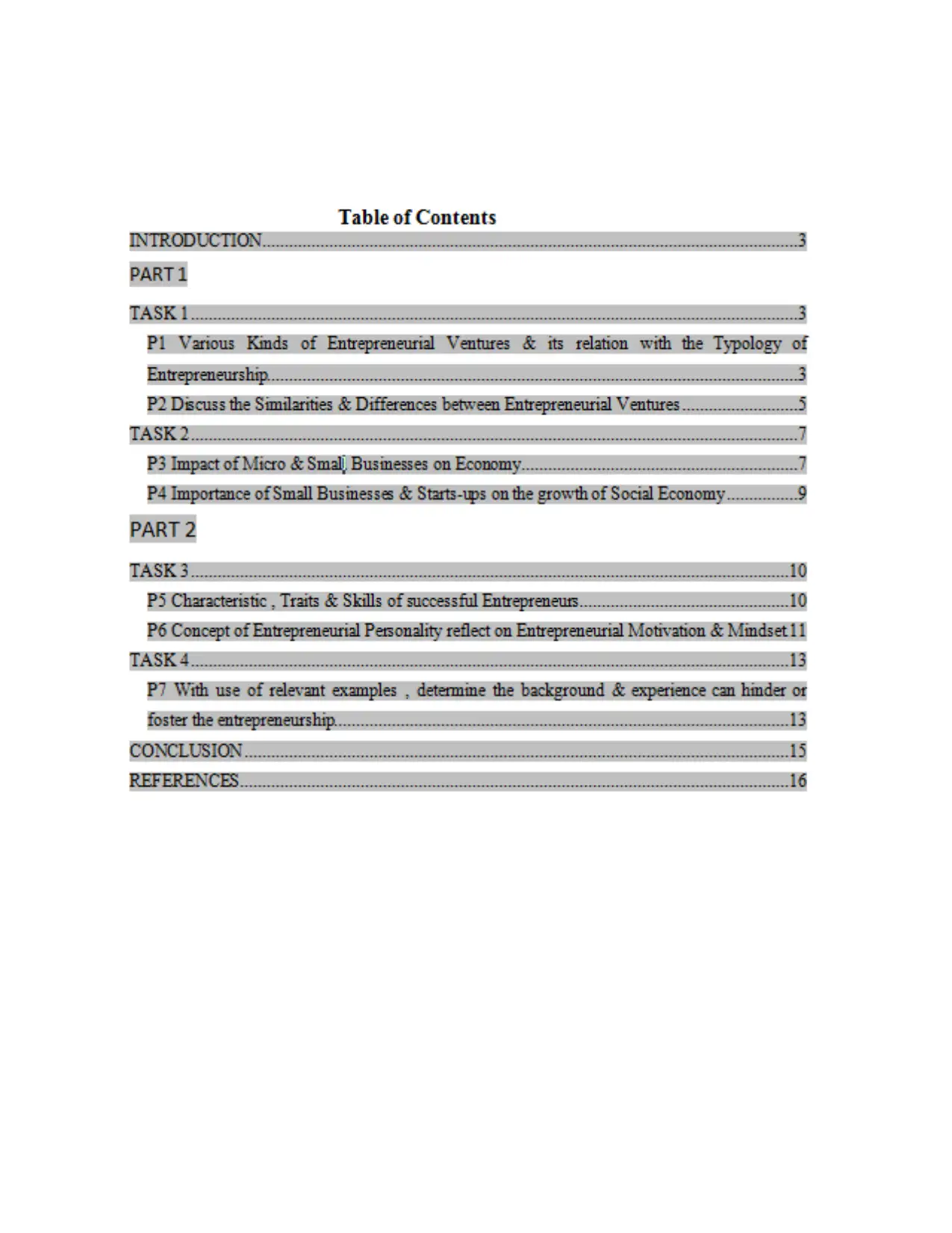

PART 1
⊘ This is a preview!⊘
Do you want full access?
Subscribe today to unlock all pages.

Trusted by 1+ million students worldwide
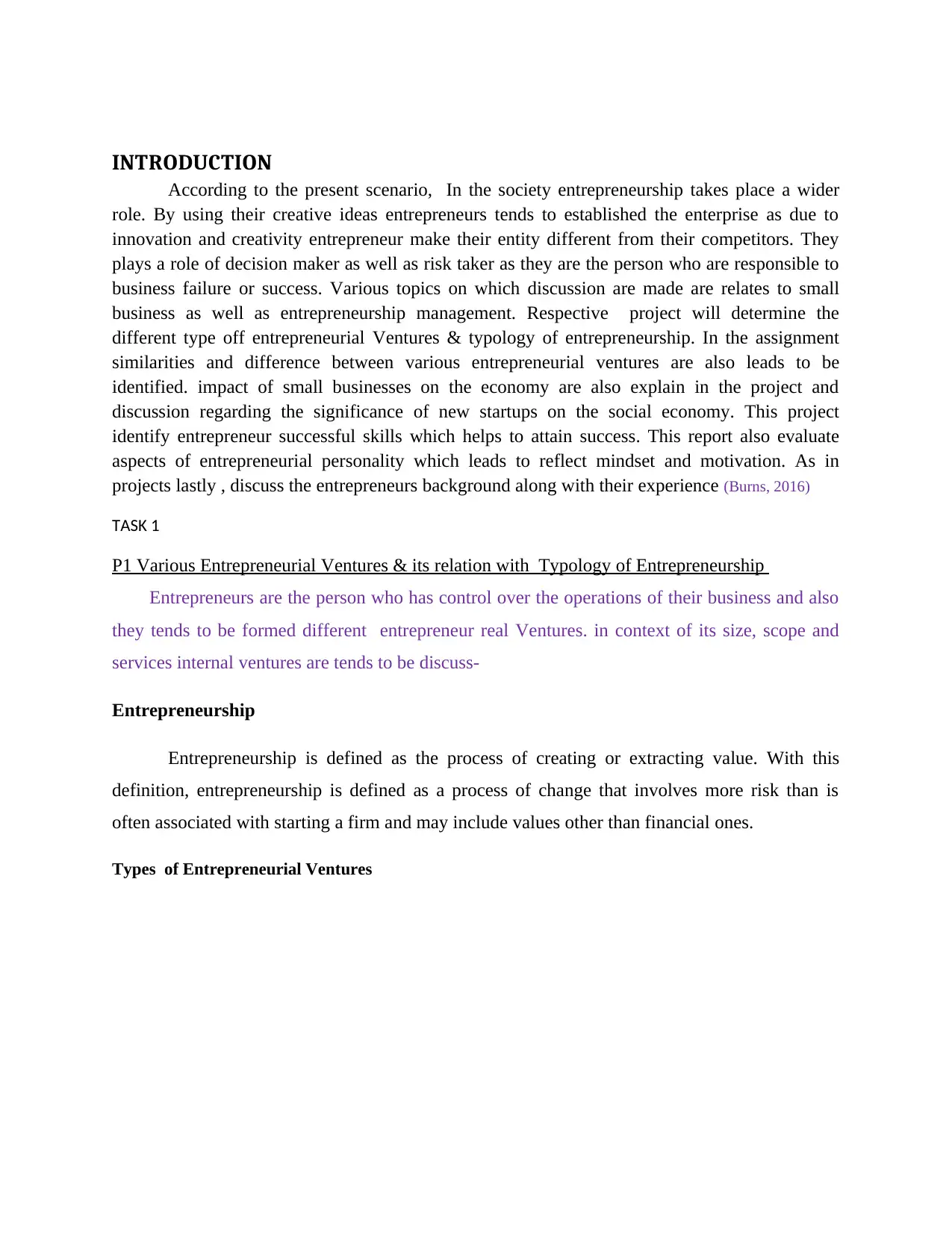
INTRODUCTION
According to the present scenario, In the society entrepreneurship takes place a wider
role. By using their creative ideas entrepreneurs tends to established the enterprise as due to
innovation and creativity entrepreneur make their entity different from their competitors. They
plays a role of decision maker as well as risk taker as they are the person who are responsible to
business failure or success. Various topics on which discussion are made are relates to small
business as well as entrepreneurship management. Respective project will determine the
different type off entrepreneurial Ventures & typology of entrepreneurship. In the assignment
similarities and difference between various entrepreneurial ventures are also leads to be
identified. impact of small businesses on the economy are also explain in the project and
discussion regarding the significance of new startups on the social economy. This project
identify entrepreneur successful skills which helps to attain success. This report also evaluate
aspects of entrepreneurial personality which leads to reflect mindset and motivation. As in
projects lastly , discuss the entrepreneurs background along with their experience (Burns, 2016)
TASK 1
P1 Various Entrepreneurial Ventures & its relation with Typology of Entrepreneurship
Entrepreneurs are the person who has control over the operations of their business and also
they tends to be formed different entrepreneur real Ventures. in context of its size, scope and
services internal ventures are tends to be discuss-
Entrepreneurship
Entrepreneurship is defined as the process of creating or extracting value. With this
definition, entrepreneurship is defined as a process of change that involves more risk than is
often associated with starting a firm and may include values other than financial ones.
Types of Entrepreneurial Ventures
According to the present scenario, In the society entrepreneurship takes place a wider
role. By using their creative ideas entrepreneurs tends to established the enterprise as due to
innovation and creativity entrepreneur make their entity different from their competitors. They
plays a role of decision maker as well as risk taker as they are the person who are responsible to
business failure or success. Various topics on which discussion are made are relates to small
business as well as entrepreneurship management. Respective project will determine the
different type off entrepreneurial Ventures & typology of entrepreneurship. In the assignment
similarities and difference between various entrepreneurial ventures are also leads to be
identified. impact of small businesses on the economy are also explain in the project and
discussion regarding the significance of new startups on the social economy. This project
identify entrepreneur successful skills which helps to attain success. This report also evaluate
aspects of entrepreneurial personality which leads to reflect mindset and motivation. As in
projects lastly , discuss the entrepreneurs background along with their experience (Burns, 2016)
TASK 1
P1 Various Entrepreneurial Ventures & its relation with Typology of Entrepreneurship
Entrepreneurs are the person who has control over the operations of their business and also
they tends to be formed different entrepreneur real Ventures. in context of its size, scope and
services internal ventures are tends to be discuss-
Entrepreneurship
Entrepreneurship is defined as the process of creating or extracting value. With this
definition, entrepreneurship is defined as a process of change that involves more risk than is
often associated with starting a firm and may include values other than financial ones.
Types of Entrepreneurial Ventures
Paraphrase This Document
Need a fresh take? Get an instant paraphrase of this document with our AI Paraphraser
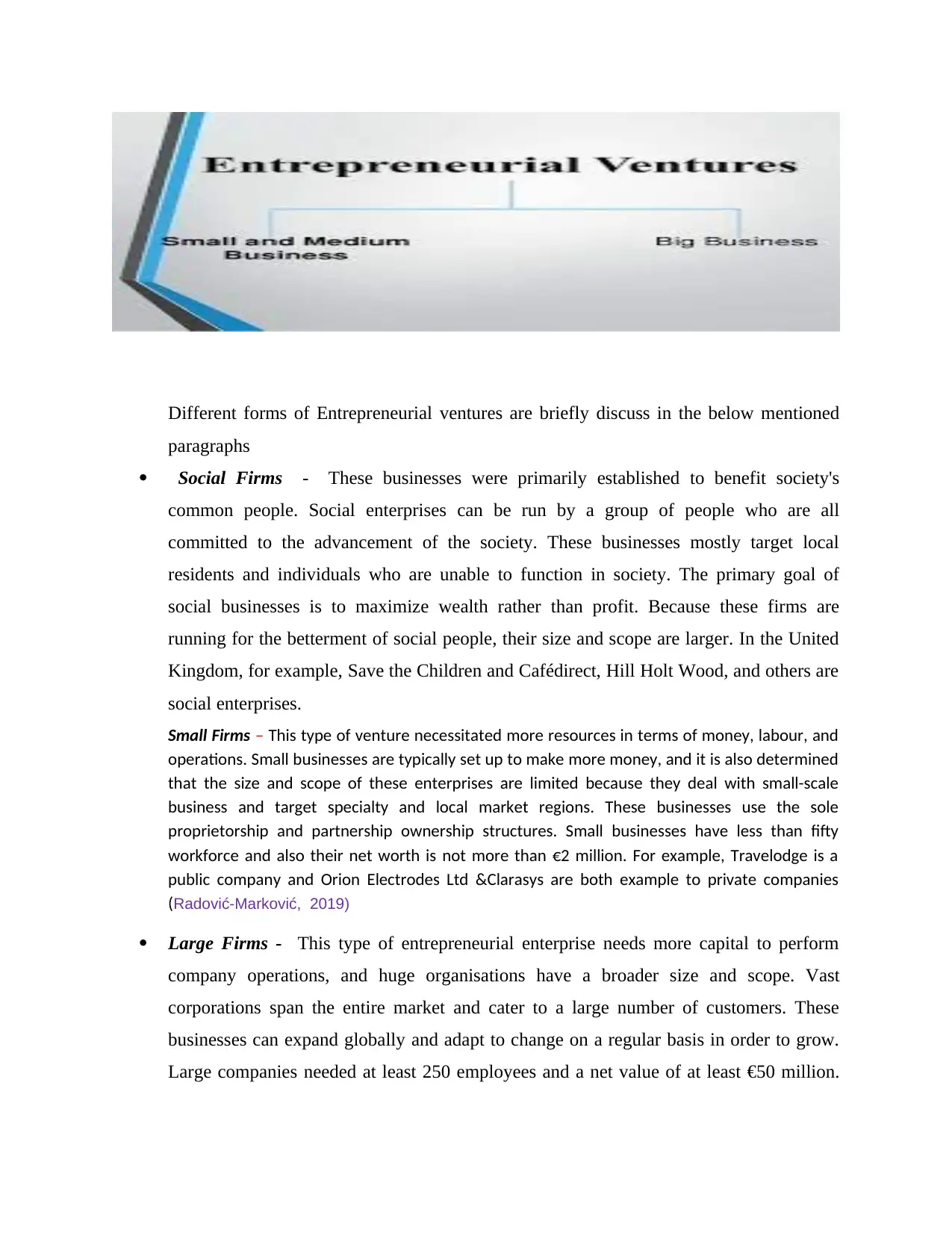
Different forms of Entrepreneurial ventures are briefly discuss in the below mentioned
paragraphs
Social Firms - These businesses were primarily established to benefit society's
common people. Social enterprises can be run by a group of people who are all
committed to the advancement of the society. These businesses mostly target local
residents and individuals who are unable to function in society. The primary goal of
social businesses is to maximize wealth rather than profit. Because these firms are
running for the betterment of social people, their size and scope are larger. In the United
Kingdom, for example, Save the Children and Cafédirect, Hill Holt Wood, and others are
social enterprises.
Small Firms – This type of venture necessitated more resources in terms of money, labour, and
operations. Small businesses are typically set up to make more money, and it is also determined
that the size and scope of these enterprises are limited because they deal with small-scale
business and target specialty and local market regions. These businesses use the sole
proprietorship and partnership ownership structures. Small businesses have less than fifty
workforce and also their net worth is not more than €2 million. For example, Travelodge is a
public company and Orion Electrodes Ltd &Clarasys are both example to private companies
(Radović-Marković, 2019)
Large Firms - This type of entrepreneurial enterprise needs more capital to perform
company operations, and huge organisations have a broader size and scope. Vast
corporations span the entire market and cater to a large number of customers. These
businesses can expand globally and adapt to change on a regular basis in order to grow.
Large companies needed at least 250 employees and a net value of at least €50 million.
paragraphs
Social Firms - These businesses were primarily established to benefit society's
common people. Social enterprises can be run by a group of people who are all
committed to the advancement of the society. These businesses mostly target local
residents and individuals who are unable to function in society. The primary goal of
social businesses is to maximize wealth rather than profit. Because these firms are
running for the betterment of social people, their size and scope are larger. In the United
Kingdom, for example, Save the Children and Cafédirect, Hill Holt Wood, and others are
social enterprises.
Small Firms – This type of venture necessitated more resources in terms of money, labour, and
operations. Small businesses are typically set up to make more money, and it is also determined
that the size and scope of these enterprises are limited because they deal with small-scale
business and target specialty and local market regions. These businesses use the sole
proprietorship and partnership ownership structures. Small businesses have less than fifty
workforce and also their net worth is not more than €2 million. For example, Travelodge is a
public company and Orion Electrodes Ltd &Clarasys are both example to private companies
(Radović-Marković, 2019)
Large Firms - This type of entrepreneurial enterprise needs more capital to perform
company operations, and huge organisations have a broader size and scope. Vast
corporations span the entire market and cater to a large number of customers. These
businesses can expand globally and adapt to change on a regular basis in order to grow.
Large companies needed at least 250 employees and a net value of at least €50 million.
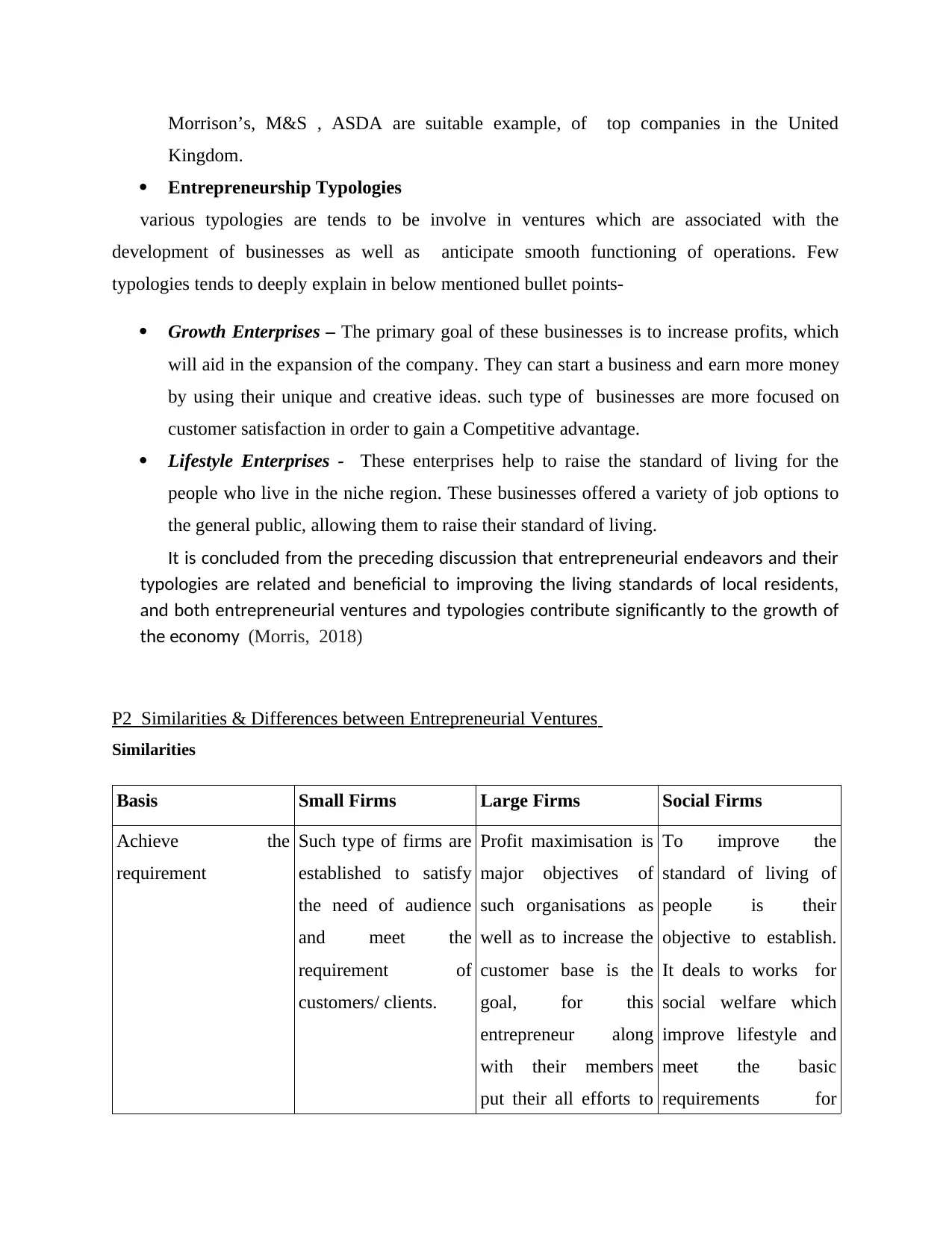
Morrison’s, M&S , ASDA are suitable example, of top companies in the United
Kingdom.
Entrepreneurship Typologies
various typologies are tends to be involve in ventures which are associated with the
development of businesses as well as anticipate smooth functioning of operations. Few
typologies tends to deeply explain in below mentioned bullet points-
Growth Enterprises – The primary goal of these businesses is to increase profits, which
will aid in the expansion of the company. They can start a business and earn more money
by using their unique and creative ideas. such type of businesses are more focused on
customer satisfaction in order to gain a Competitive advantage.
Lifestyle Enterprises - These enterprises help to raise the standard of living for the
people who live in the niche region. These businesses offered a variety of job options to
the general public, allowing them to raise their standard of living.
It is concluded from the preceding discussion that entrepreneurial endeavors and their
typologies are related and beneficial to improving the living standards of local residents,
and both entrepreneurial ventures and typologies contribute significantly to the growth of
the economy (Morris, 2018)
P2 Similarities & Differences between Entrepreneurial Ventures
Similarities
Basis Small Firms Large Firms Social Firms
Achieve the
requirement
Such type of firms are
established to satisfy
the need of audience
and meet the
requirement of
customers/ clients.
Profit maximisation is
major objectives of
such organisations as
well as to increase the
customer base is the
goal, for this
entrepreneur along
with their members
put their all efforts to
To improve the
standard of living of
people is their
objective to establish.
It deals to works for
social welfare which
improve lifestyle and
meet the basic
requirements for
Kingdom.
Entrepreneurship Typologies
various typologies are tends to be involve in ventures which are associated with the
development of businesses as well as anticipate smooth functioning of operations. Few
typologies tends to deeply explain in below mentioned bullet points-
Growth Enterprises – The primary goal of these businesses is to increase profits, which
will aid in the expansion of the company. They can start a business and earn more money
by using their unique and creative ideas. such type of businesses are more focused on
customer satisfaction in order to gain a Competitive advantage.
Lifestyle Enterprises - These enterprises help to raise the standard of living for the
people who live in the niche region. These businesses offered a variety of job options to
the general public, allowing them to raise their standard of living.
It is concluded from the preceding discussion that entrepreneurial endeavors and their
typologies are related and beneficial to improving the living standards of local residents,
and both entrepreneurial ventures and typologies contribute significantly to the growth of
the economy (Morris, 2018)
P2 Similarities & Differences between Entrepreneurial Ventures
Similarities
Basis Small Firms Large Firms Social Firms
Achieve the
requirement
Such type of firms are
established to satisfy
the need of audience
and meet the
requirement of
customers/ clients.
Profit maximisation is
major objectives of
such organisations as
well as to increase the
customer base is the
goal, for this
entrepreneur along
with their members
put their all efforts to
To improve the
standard of living of
people is their
objective to establish.
It deals to works for
social welfare which
improve lifestyle and
meet the basic
requirements for
⊘ This is a preview!⊘
Do you want full access?
Subscribe today to unlock all pages.

Trusted by 1+ million students worldwide
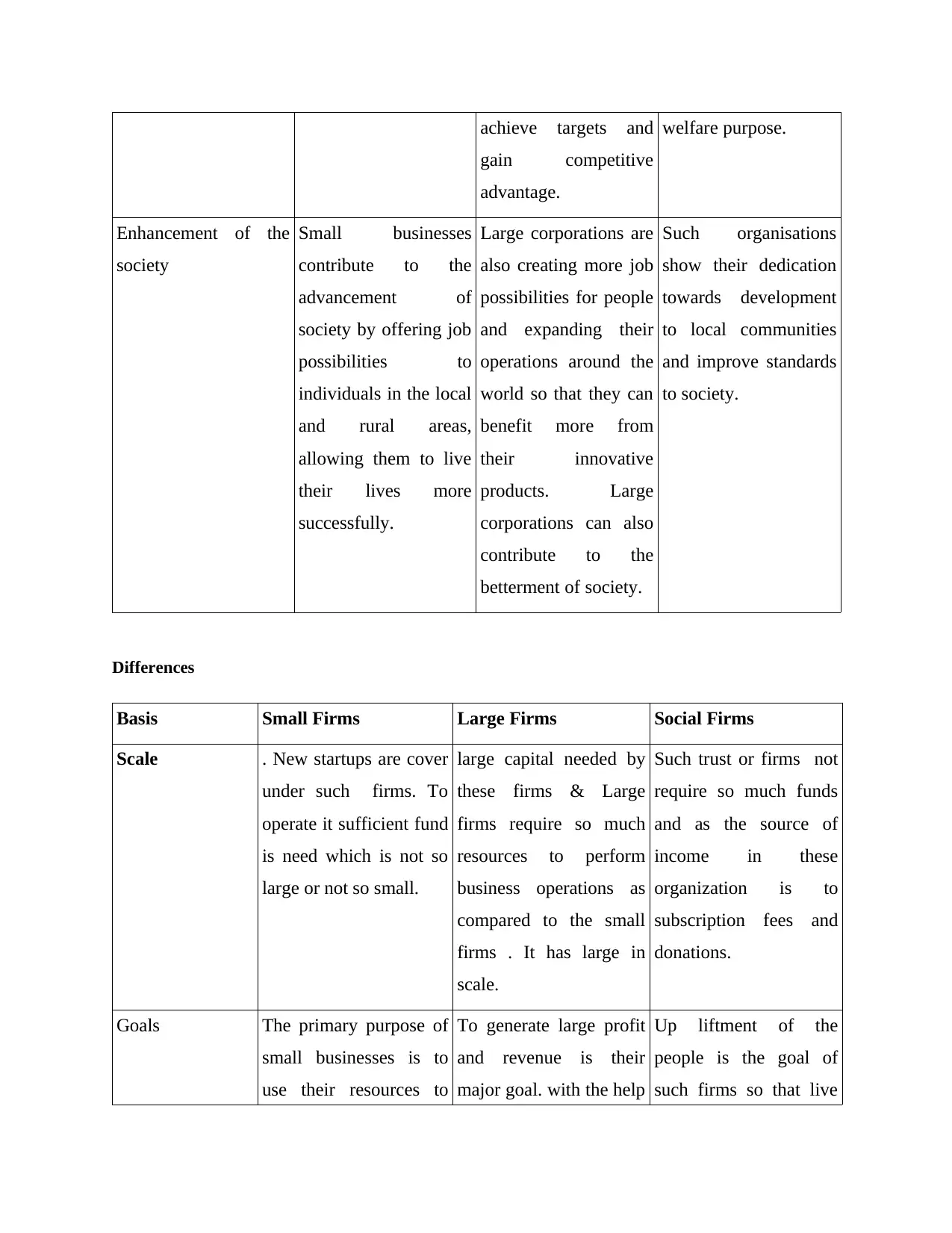
achieve targets and
gain competitive
advantage.
welfare purpose.
Enhancement of the
society
Small businesses
contribute to the
advancement of
society by offering job
possibilities to
individuals in the local
and rural areas,
allowing them to live
their lives more
successfully.
Large corporations are
also creating more job
possibilities for people
and expanding their
operations around the
world so that they can
benefit more from
their innovative
products. Large
corporations can also
contribute to the
betterment of society.
Such organisations
show their dedication
towards development
to local communities
and improve standards
to society.
Differences
Basis Small Firms Large Firms Social Firms
Scale . New startups are cover
under such firms. To
operate it sufficient fund
is need which is not so
large or not so small.
large capital needed by
these firms & Large
firms require so much
resources to perform
business operations as
compared to the small
firms . It has large in
scale.
Such trust or firms not
require so much funds
and as the source of
income in these
organization is to
subscription fees and
donations.
Goals The primary purpose of
small businesses is to
use their resources to
To generate large profit
and revenue is their
major goal. with the help
Up liftment of the
people is the goal of
such firms so that live
gain competitive
advantage.
welfare purpose.
Enhancement of the
society
Small businesses
contribute to the
advancement of
society by offering job
possibilities to
individuals in the local
and rural areas,
allowing them to live
their lives more
successfully.
Large corporations are
also creating more job
possibilities for people
and expanding their
operations around the
world so that they can
benefit more from
their innovative
products. Large
corporations can also
contribute to the
betterment of society.
Such organisations
show their dedication
towards development
to local communities
and improve standards
to society.
Differences
Basis Small Firms Large Firms Social Firms
Scale . New startups are cover
under such firms. To
operate it sufficient fund
is need which is not so
large or not so small.
large capital needed by
these firms & Large
firms require so much
resources to perform
business operations as
compared to the small
firms . It has large in
scale.
Such trust or firms not
require so much funds
and as the source of
income in these
organization is to
subscription fees and
donations.
Goals The primary purpose of
small businesses is to
use their resources to
To generate large profit
and revenue is their
major goal. with the help
Up liftment of the
people is the goal of
such firms so that live
Paraphrase This Document
Need a fresh take? Get an instant paraphrase of this document with our AI Paraphraser
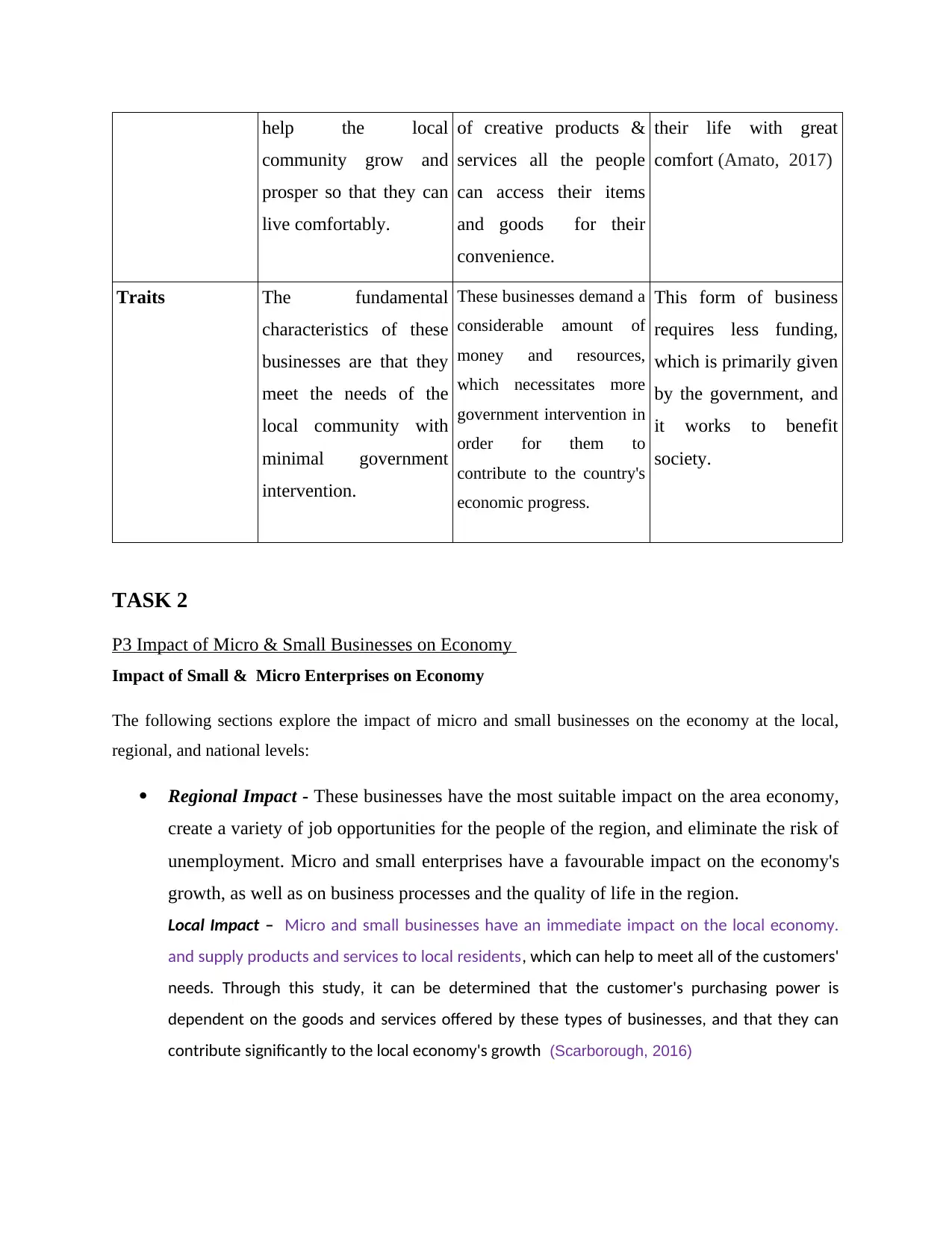
help the local
community grow and
prosper so that they can
live comfortably.
of creative products &
services all the people
can access their items
and goods for their
convenience.
their life with great
comfort (Amato, 2017)
Traits The fundamental
characteristics of these
businesses are that they
meet the needs of the
local community with
minimal government
intervention.
These businesses demand a
considerable amount of
money and resources,
which necessitates more
government intervention in
order for them to
contribute to the country's
economic progress.
This form of business
requires less funding,
which is primarily given
by the government, and
it works to benefit
society.
TASK 2
P3 Impact of Micro & Small Businesses on Economy
Impact of Small & Micro Enterprises on Economy
The following sections explore the impact of micro and small businesses on the economy at the local,
regional, and national levels:
Regional Impact - These businesses have the most suitable impact on the area economy,
create a variety of job opportunities for the people of the region, and eliminate the risk of
unemployment. Micro and small enterprises have a favourable impact on the economy's
growth, as well as on business processes and the quality of life in the region.
Local Impact – Micro and small businesses have an immediate impact on the local economy.
and supply products and services to local residents, which can help to meet all of the customers'
needs. Through this study, it can be determined that the customer's purchasing power is
dependent on the goods and services offered by these types of businesses, and that they can
contribute significantly to the local economy's growth (Scarborough, 2016)
community grow and
prosper so that they can
live comfortably.
of creative products &
services all the people
can access their items
and goods for their
convenience.
their life with great
comfort (Amato, 2017)
Traits The fundamental
characteristics of these
businesses are that they
meet the needs of the
local community with
minimal government
intervention.
These businesses demand a
considerable amount of
money and resources,
which necessitates more
government intervention in
order for them to
contribute to the country's
economic progress.
This form of business
requires less funding,
which is primarily given
by the government, and
it works to benefit
society.
TASK 2
P3 Impact of Micro & Small Businesses on Economy
Impact of Small & Micro Enterprises on Economy
The following sections explore the impact of micro and small businesses on the economy at the local,
regional, and national levels:
Regional Impact - These businesses have the most suitable impact on the area economy,
create a variety of job opportunities for the people of the region, and eliminate the risk of
unemployment. Micro and small enterprises have a favourable impact on the economy's
growth, as well as on business processes and the quality of life in the region.
Local Impact – Micro and small businesses have an immediate impact on the local economy.
and supply products and services to local residents, which can help to meet all of the customers'
needs. Through this study, it can be determined that the customer's purchasing power is
dependent on the goods and services offered by these types of businesses, and that they can
contribute significantly to the local economy's growth (Scarborough, 2016)
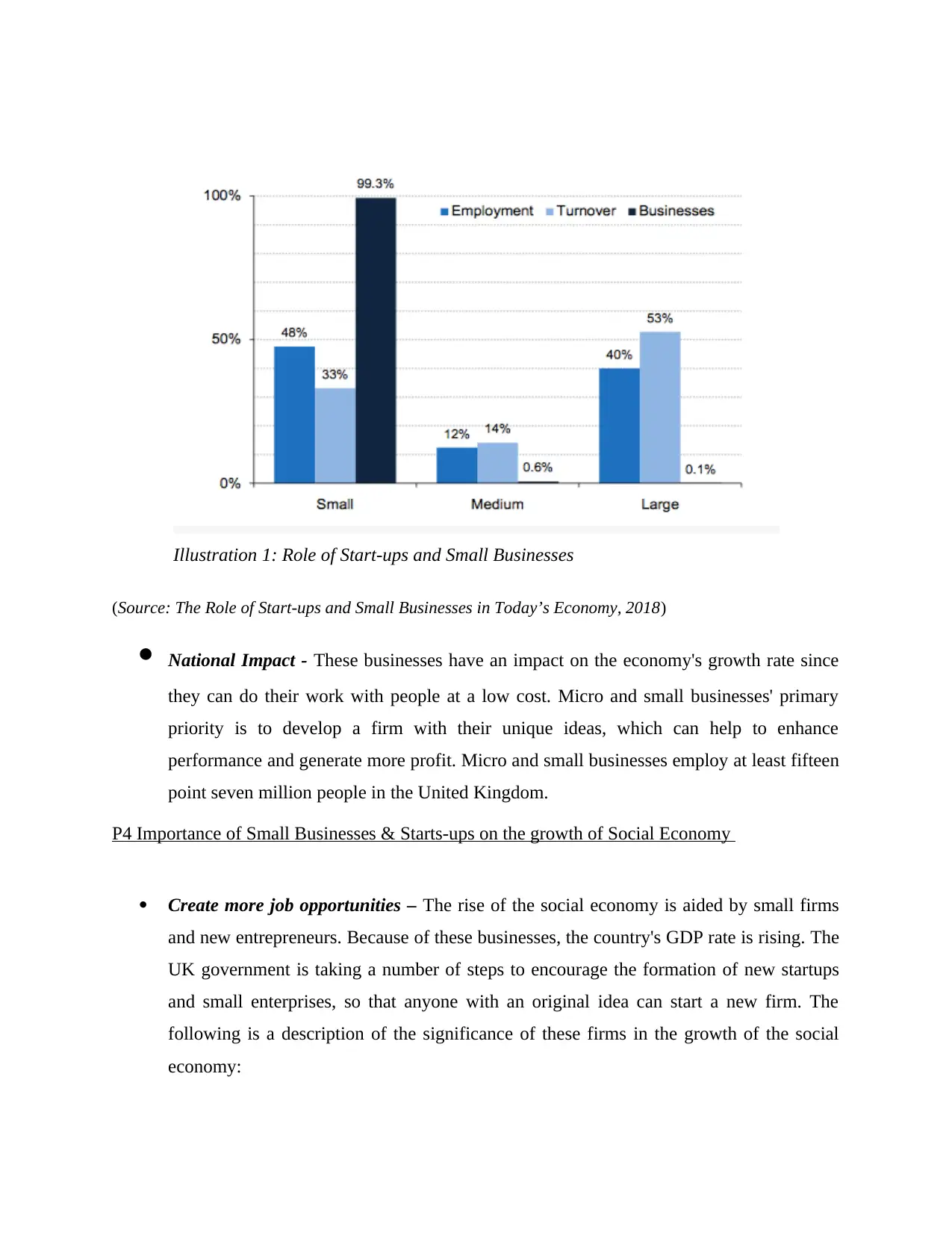
(Source: The Role of Start-ups and Small Businesses in Today’s Economy, 2018)
National Impact - These businesses have an impact on the economy's growth rate since
they can do their work with people at a low cost. Micro and small businesses' primary
priority is to develop a firm with their unique ideas, which can help to enhance
performance and generate more profit. Micro and small businesses employ at least fifteen
point seven million people in the United Kingdom.
P4 Importance of Small Businesses & Starts-ups on the growth of Social Economy
Create more job opportunities – The rise of the social economy is aided by small firms
and new entrepreneurs. Because of these businesses, the country's GDP rate is rising. The
UK government is taking a number of steps to encourage the formation of new startups
and small enterprises, so that anyone with an original idea can start a new firm. The
following is a description of the significance of these firms in the growth of the social
economy:
Illustration 1: Role of Start-ups and Small Businesses
National Impact - These businesses have an impact on the economy's growth rate since
they can do their work with people at a low cost. Micro and small businesses' primary
priority is to develop a firm with their unique ideas, which can help to enhance
performance and generate more profit. Micro and small businesses employ at least fifteen
point seven million people in the United Kingdom.
P4 Importance of Small Businesses & Starts-ups on the growth of Social Economy
Create more job opportunities – The rise of the social economy is aided by small firms
and new entrepreneurs. Because of these businesses, the country's GDP rate is rising. The
UK government is taking a number of steps to encourage the formation of new startups
and small enterprises, so that anyone with an original idea can start a new firm. The
following is a description of the significance of these firms in the growth of the social
economy:
Illustration 1: Role of Start-ups and Small Businesses
⊘ This is a preview!⊘
Do you want full access?
Subscribe today to unlock all pages.

Trusted by 1+ million students worldwide

Economic Growth – In general, small companies contribute to the country's economic
progress and serve the local population. These kind of businesses are accountable for
their own work and do not require more government intervention. Entrepreneurs can
come up with innovative items and make more money to attract clients, as well as
contribute their best to economic growth. All businesses can pay taxes, which will aid the
country's financial situation (Mashizha, 2019)
Improve living standard - These types of businesses also serve to raise people's living
standards and boost the social economy's growth rate. A new business may be the ideal
initiative for improving the living conditions of local residents and assisting them in
establishing a solid social position
According to the debate above, both small enterprises and startups play an important part
in the expansion of the social economy by providing many job opportunities to the
general public (Steyn, 2017)
progress and serve the local population. These kind of businesses are accountable for
their own work and do not require more government intervention. Entrepreneurs can
come up with innovative items and make more money to attract clients, as well as
contribute their best to economic growth. All businesses can pay taxes, which will aid the
country's financial situation (Mashizha, 2019)
Improve living standard - These types of businesses also serve to raise people's living
standards and boost the social economy's growth rate. A new business may be the ideal
initiative for improving the living conditions of local residents and assisting them in
establishing a solid social position
According to the debate above, both small enterprises and startups play an important part
in the expansion of the social economy by providing many job opportunities to the
general public (Steyn, 2017)
Paraphrase This Document
Need a fresh take? Get an instant paraphrase of this document with our AI Paraphraser
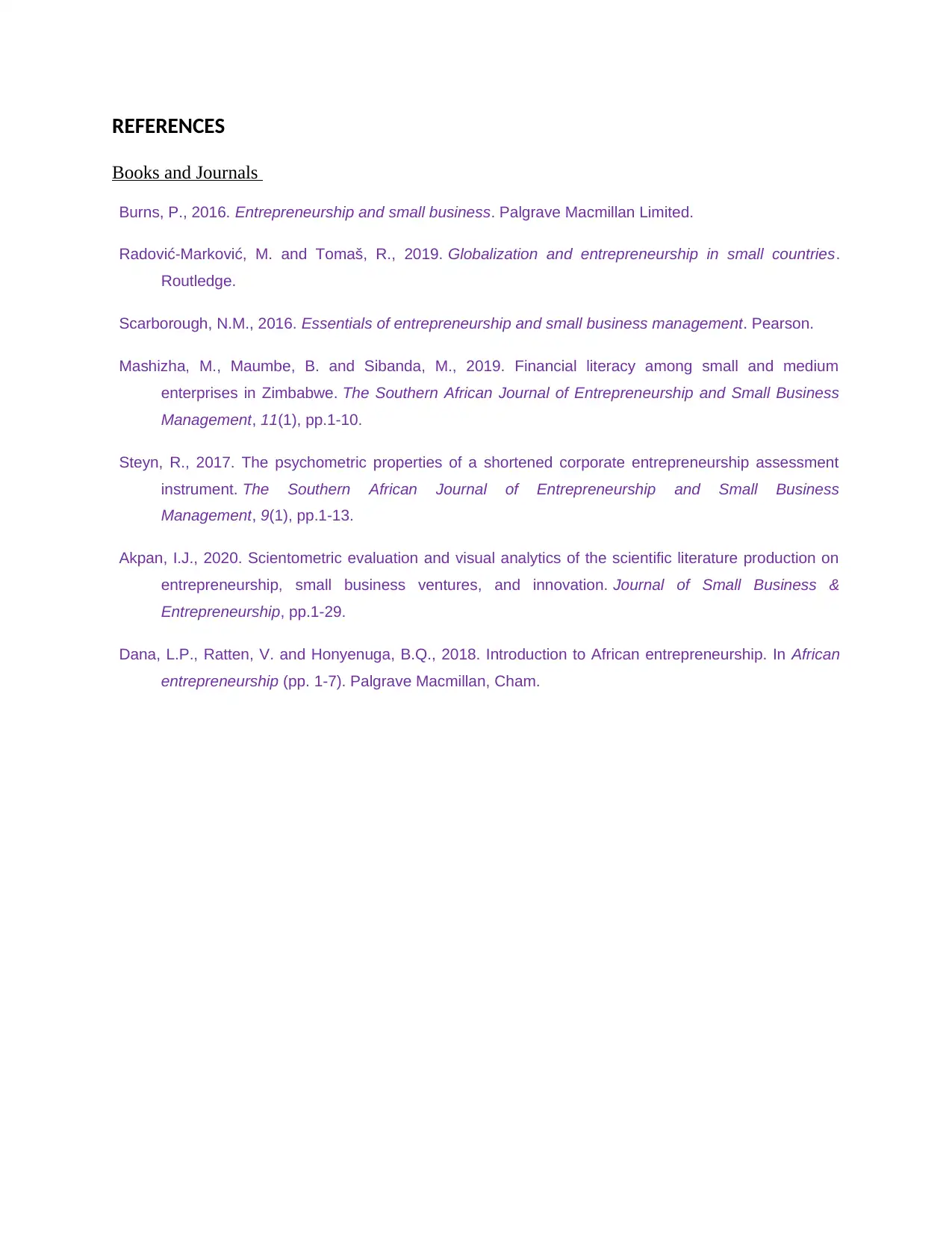
REFERENCES
Books and Journals
Burns, P., 2016. Entrepreneurship and small business. Palgrave Macmillan Limited.
Radović-Marković, M. and Tomaš, R., 2019. Globalization and entrepreneurship in small countries.
Routledge.
Scarborough, N.M., 2016. Essentials of entrepreneurship and small business management. Pearson.
Mashizha, M., Maumbe, B. and Sibanda, M., 2019. Financial literacy among small and medium
enterprises in Zimbabwe. The Southern African Journal of Entrepreneurship and Small Business
Management, 11(1), pp.1-10.
Steyn, R., 2017. The psychometric properties of a shortened corporate entrepreneurship assessment
instrument. The Southern African Journal of Entrepreneurship and Small Business
Management, 9(1), pp.1-13.
Akpan, I.J., 2020. Scientometric evaluation and visual analytics of the scientific literature production on
entrepreneurship, small business ventures, and innovation. Journal of Small Business &
Entrepreneurship, pp.1-29.
Dana, L.P., Ratten, V. and Honyenuga, B.Q., 2018. Introduction to African entrepreneurship. In African
entrepreneurship (pp. 1-7). Palgrave Macmillan, Cham.
Books and Journals
Burns, P., 2016. Entrepreneurship and small business. Palgrave Macmillan Limited.
Radović-Marković, M. and Tomaš, R., 2019. Globalization and entrepreneurship in small countries.
Routledge.
Scarborough, N.M., 2016. Essentials of entrepreneurship and small business management. Pearson.
Mashizha, M., Maumbe, B. and Sibanda, M., 2019. Financial literacy among small and medium
enterprises in Zimbabwe. The Southern African Journal of Entrepreneurship and Small Business
Management, 11(1), pp.1-10.
Steyn, R., 2017. The psychometric properties of a shortened corporate entrepreneurship assessment
instrument. The Southern African Journal of Entrepreneurship and Small Business
Management, 9(1), pp.1-13.
Akpan, I.J., 2020. Scientometric evaluation and visual analytics of the scientific literature production on
entrepreneurship, small business ventures, and innovation. Journal of Small Business &
Entrepreneurship, pp.1-29.
Dana, L.P., Ratten, V. and Honyenuga, B.Q., 2018. Introduction to African entrepreneurship. In African
entrepreneurship (pp. 1-7). Palgrave Macmillan, Cham.

PART - 2
⊘ This is a preview!⊘
Do you want full access?
Subscribe today to unlock all pages.

Trusted by 1+ million students worldwide
1 out of 19
Related Documents
Your All-in-One AI-Powered Toolkit for Academic Success.
+13062052269
info@desklib.com
Available 24*7 on WhatsApp / Email
![[object Object]](/_next/static/media/star-bottom.7253800d.svg)
Unlock your academic potential
Copyright © 2020–2025 A2Z Services. All Rights Reserved. Developed and managed by ZUCOL.



